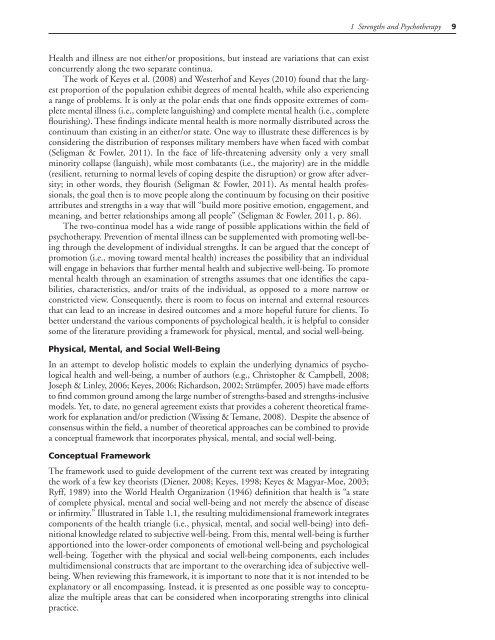Tools for Strengths-Based Assessment and Evaluation - Springer ...
Tools for Strengths-Based Assessment and Evaluation - Springer ...
Tools for Strengths-Based Assessment and Evaluation - Springer ...
Create successful ePaper yourself
Turn your PDF publications into a flip-book with our unique Google optimized e-Paper software.
1 <strong>Strengths</strong> <strong>and</strong> Psychotherapy 9<br />
Health <strong>and</strong> illness are not either/or propositions, but instead are variations that can exist<br />
concurrently along the two separate continua.<br />
The work of Keyes et al. (2008) <strong>and</strong> Westerhof <strong>and</strong> Keyes (2010) found that the largest<br />
proportion of the population exhibit degrees of mental health, while also experiencing<br />
a range of problems. It is only at the polar ends that one finds opposite extremes of complete<br />
mental illness (i.e., complete languishing) <strong>and</strong> complete mental health (i.e., complete<br />
flourishing). These findings indicate mental health is more normally distributed across the<br />
continuum than existing in an either/or state. One way to illustrate these differences is by<br />
considering the distribution of responses military members have when faced with combat<br />
(Seligman & Fowler, 2011). In the face of life-threatening adversity only a very small<br />
minority collapse (languish), while most combatants (i.e., the majority) are in the middle<br />
(resilient, returning to normal levels of coping despite the disruption) or grow after adversity;<br />
in other words, they flourish (Seligman & Fowler, 2011). As mental health professionals,<br />
the goal then is to move people along the continuum by focusing on their positive<br />
attributes <strong>and</strong> strengths in a way that will “build more positive emotion, engagement, <strong>and</strong><br />
meaning, <strong>and</strong> better relationships among all people” (Seligman & Fowler, 2011, p. 86).<br />
The two-continua model has a wide range of possible applications within the field of<br />
psychotherapy. Prevention of mental illness can be supplemented with promoting well-being<br />
through the development of individual strengths. It can be argued that the concept of<br />
promotion (i.e., moving toward mental health) increases the possibility that an individual<br />
will engage in behaviors that further mental health <strong>and</strong> subjective well-being. To promote<br />
mental health through an examination of strengths assumes that one identifies the capabilities,<br />
characteristics, <strong>and</strong>/or traits of the individual, as opposed to a more narrow or<br />
constricted view. Consequently, there is room to focus on internal <strong>and</strong> external resources<br />
that can lead to an increase in desired outcomes <strong>and</strong> a more hopeful future <strong>for</strong> clients. To<br />
better underst<strong>and</strong> the various components of psychological health, it is helpful to consider<br />
some of the literature providing a framework <strong>for</strong> physical, mental, <strong>and</strong> social well-being.<br />
Physical, Mental, <strong>and</strong> Social Well-Being<br />
In an attempt to develop holistic models to explain the underlying dynamics of psychological<br />
health <strong>and</strong> well-being, a number of authors (e.g., Christopher & Campbell, 2008;<br />
Joseph & Linley, 2006; Keyes, 2006; Richardson, 2002; Strümpfer, 2005) have made ef<strong>for</strong>ts<br />
to find common ground among the large number of strengths-based <strong>and</strong> strengths-inclusive<br />
models. Yet, to date, no general agreement exists that provides a coherent theoretical framework<br />
<strong>for</strong> explanation <strong>and</strong>/or prediction (Wissing & Temane, 2008). Despite the absence of<br />
consensus within the field, a number of theoretical approaches can be combined to provide<br />
a conceptual framework that incorporates physical, mental, <strong>and</strong> social well-being.<br />
Conceptual Framework<br />
The framework used to guide development of the current text was created by integrating<br />
the work of a few key theorists (Diener, 2008; Keyes, 1998; Keyes & Magyar-Moe, 2003;<br />
Ryff, 1989) into the World Health Organization (1946) definition that health is “a state<br />
of complete physical, mental <strong>and</strong> social well-being <strong>and</strong> not merely the absence of disease<br />
or infirmity.” Illustrated in Table 1.1, the resulting multidimensional framework integrates<br />
components of the health triangle (i.e., physical, mental, <strong>and</strong> social well-being) into definitional<br />
knowledge related to subjective well-being. From this, mental well-being is further<br />
apportioned into the lower-order components of emotional well-being <strong>and</strong> psychological<br />
well-being. Together with the physical <strong>and</strong> social well-being components, each includes<br />
multidimensional constructs that are important to the overarching idea of subjective wellbeing.<br />
When reviewing this framework, it is important to note that it is not intended to be<br />
explanatory or all encompassing. Instead, it is presented as one possible way to conceptualize<br />
the multiple areas that can be considered when incorporating strengths into clinical<br />
practice.

















